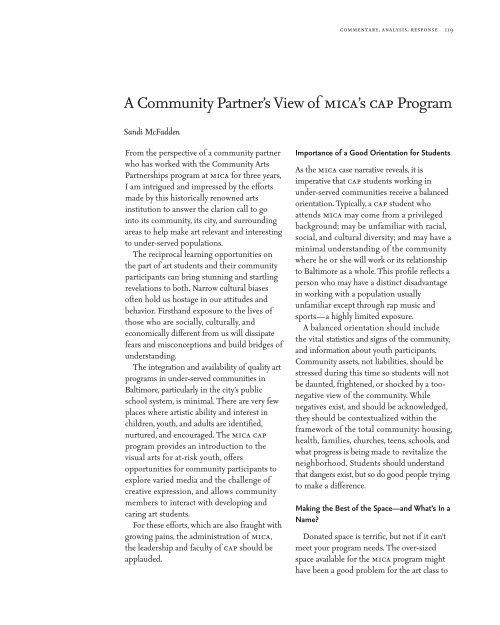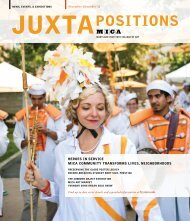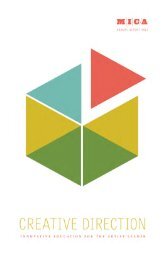art/vision/voice - Maryland Institute College of Art
art/vision/voice - Maryland Institute College of Art
art/vision/voice - Maryland Institute College of Art
You also want an ePaper? Increase the reach of your titles
YUMPU automatically turns print PDFs into web optimized ePapers that Google loves.
From the perspective <strong>of</strong> a community p<strong>art</strong>ner<br />
who has worked with the Community <strong>Art</strong>s<br />
P<strong>art</strong>nerships program at mica for three years,<br />
I am intrigued and impressed by the efforts<br />
made by this historically renowned <strong>art</strong>s<br />
institution to answer the clarion call to go<br />
into its community, its city, and surrounding<br />
areas to help make <strong>art</strong> relevant and interesting<br />
to under-served populations.<br />
The reciprocal learning opportunities on<br />
the p<strong>art</strong> <strong>of</strong> <strong>art</strong> students and their community<br />
p<strong>art</strong>icipants can bring stunning and st<strong>art</strong>ling<br />
revelations to both. Narrow cultural biases<br />
<strong>of</strong>ten hold us hostage in our attitudes and<br />
behavior. Firsthand exposure to the lives <strong>of</strong><br />
those who are socially, culturally, and<br />
economically different from us will dissipate<br />
fears and misconceptions and build bridges <strong>of</strong><br />
understanding.<br />
The integration and availability <strong>of</strong> quality <strong>art</strong><br />
programs in under-served communities in<br />
Baltimore, p<strong>art</strong>icularly in the city’s public<br />
school system, is minimal. There are very few<br />
places where <strong>art</strong>istic ability and interest in<br />
children, youth, and adults are identified,<br />
nurtured, and encouraged. The mica cap<br />
program provides an introduction to the<br />
visual <strong>art</strong>s for at-risk youth, <strong>of</strong>fers<br />
opportunities for community p<strong>art</strong>icipants to<br />
explore varied media and the challenge <strong>of</strong><br />
creative expression, and allows community<br />
members to interact with developing and<br />
caring <strong>art</strong> students.<br />
For these efforts, which are also fraught with<br />
growing pains, the administration <strong>of</strong> mica,<br />
the leadership and faculty <strong>of</strong> cap should be<br />
applauded.<br />
commentary, analysis, response 119<br />
A Community P<strong>art</strong>ner’s View <strong>of</strong> mica’s cap Program<br />
Sandi McFadden<br />
Importance <strong>of</strong> a Good Orientation for Students<br />
As the mica case narrative reveals, it is<br />
imperative that cap students working in<br />
under-served communities receive a balanced<br />
orientation. Typically, a cap student who<br />
attends mica may come from a privileged<br />
background; may be unfamiliar with racial,<br />
social, and cultural diversity; and may have a<br />
minimal understanding <strong>of</strong> the community<br />
where he or she will work or its relationship<br />
to Baltimore as a whole. This pr<strong>of</strong>ile reflects a<br />
person who may have a distinct disadvantage<br />
in working with a population usually<br />
unfamiliar except through rap music and<br />
sports—a highly limited exposure.<br />
A balanced orientation should include<br />
the vital statistics and signs <strong>of</strong> the community,<br />
and information about youth p<strong>art</strong>icipants.<br />
Community assets, not liabilities, should be<br />
stressed during this time so students will not<br />
be daunted, frightened, or shocked by a toonegative<br />
view <strong>of</strong> the community. While<br />
negatives exist, and should be acknowledged,<br />
they should be contextualized within the<br />
framework <strong>of</strong> the total community: housing,<br />
health, families, churches, teens, schools, and<br />
what progress is being made to revitalize the<br />
neighborhood. Students should understand<br />
that dangers exist, but so do good people trying<br />
to make a difference.<br />
Making the Best <strong>of</strong> the Space—and What’s In a<br />
Name?<br />
Donated space is terrific, but not if it can’t<br />
meet your program needs. The over-sized<br />
space available for the mica program might<br />
have been a good problem for the <strong>art</strong> class to
















